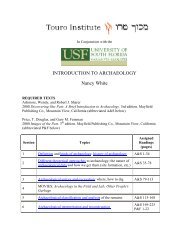In Conjunction with Cultural Anthropology - Touro Institute
In Conjunction with Cultural Anthropology - Touro Institute
In Conjunction with Cultural Anthropology - Touro Institute
Create successful ePaper yourself
Turn your PDF publications into a flip-book with our unique Google optimized e-Paper software.
9. Divorce is most likely where:<br />
a. bride price is customary.<br />
b. dowry is customary.<br />
c. it is customary for the couple to live in an extended family.<br />
d. income is unrelated to kinship ties and neolocal residence is practiced.<br />
10. High social rank is LEAST likely to be associated <strong>with</strong> old age where:<br />
a. the married couple are economically independent from other relatives.<br />
b. post-marital residence rules require a couple to live near one spouse’s parents.<br />
c. older people live <strong>with</strong> related married couples<br />
d. descent is traced through only one of the parents rather than through both.<br />
11. Which of the following is NOT true of funeral rituals?<br />
a. They encourage the survivors to adjust to the absence of the deceased.<br />
b. They provide a setting in which issues of property rights are settled.<br />
c. They pass on the statuses of the deceased to new persons.<br />
d. They usually have little emphasis on religious ritual symbolism.<br />
Matching Exercise - Chapter 9: The Life Cycle<br />
1. life cycle<br />
2. rite of passage<br />
3. pregnancy rituals<br />
4. marking<br />
5. couvade<br />
6. naming ceremony<br />
7. puberty ritual<br />
8. circumcision<br />
9. scarification<br />
10. sleep crawling<br />
11. teknonymy<br />
12. divorce<br />
13. biological death<br />
14. psychological death<br />
15. social death<br />
16. funeral ritual<br />
a. the process by which one subjectively prepares for impending biological death<br />
b. the idea that the behaviors of a woman during pregnancy may influence the physical<br />
or psychological characteristics of the unborn child<br />
c. the termination of a marriage relationship<br />
d. the custom of referring to a person as the parent of his or her child rather than by birth<br />
name<br />
e. a rite of passage that formalizes the change from the status of child to the status of<br />
adult<br />
f. a rite of passage that formalizes the removal of an individual from the status of living<br />
member of the social group<br />
g. religious rules such as taboos designed to protect the unborn child and the mother<br />
during pregnancy and childbirth or admonitions to engage in acts believed to be a<br />
positive influence on the developing child<br />
h. the surgical removal of the foreskin from the penis
















